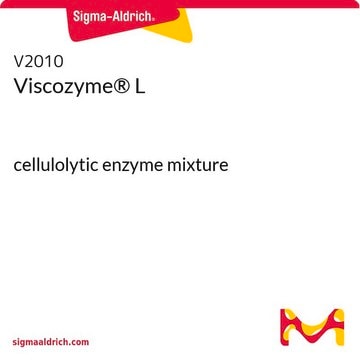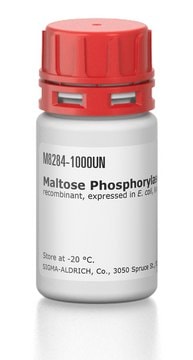This product is provided as a slurry containing 10 mg of enzyme in saturated ammonium sulfate precipitate. It is supplied at 100 units, with a concentration of 0.13 units per 1 mg of protein at 10 mg per ml.
Wichtige Dokumente
E6412
Cellobiohydrolase I from Hypocrea jecorina
0.13 U/mg, recombinant, expressed in corn
Synonym(e):
Cel7A, Cellobiosidase, Cellulase
Größe auswählen
CHF 159.00
Größe auswählen
About This Item
CHF 159.00
Empfohlene Produkte
Rekombinant
expressed in corn
Form
liquid
Spezifische Aktivität
0.13 U/mg
Grünere Alternativprodukt-Eigenschaften
Design for Energy Efficiency
Learn more about the Principles of Green Chemistry.
sustainability
Greener Alternative Product
Grünere Alternativprodukt-Kategorie
Versandbedingung
dry ice
Lagertemp.
−20°C
Verwandte Kategorien
Allgemeine Beschreibung
Anwendung
Biochem./physiol. Wirkung
Einheitendefinition
Physikalische Form
Signalwort
Danger
H-Sätze
P-Sätze
Gefahreneinstufungen
Resp. Sens. 1
Lagerklassenschlüssel
10 - Combustible liquids
WGK
WGK 3
Flammpunkt (°F)
Not applicable
Flammpunkt (°C)
Not applicable
Hier finden Sie alle aktuellen Versionen:
Analysenzertifikate (COA)
Die passende Version wird nicht angezeigt?
Wenn Sie eine bestimmte Version benötigen, können Sie anhand der Lot- oder Chargennummer nach einem spezifischen Zertifikat suchen.
Besitzen Sie dieses Produkt bereits?
In der Dokumentenbibliothek finden Sie die Dokumentation zu den Produkten, die Sie kürzlich erworben haben.
Kunden haben sich ebenfalls angesehen
Artikel
Uncover more about glycosaminoglycans and proteoglycans including the structure of glycosaminoglycans (GAGs), the different types of GAGs, and their functions.
-
Good morning. This material is liquid. Could you tell me the volume that comes in the bottle?
1 answer-
Helpful?
-
Active Filters
Unser Team von Wissenschaftlern verfügt über Erfahrung in allen Forschungsbereichen einschließlich Life Science, Materialwissenschaften, chemischer Synthese, Chromatographie, Analytik und vielen mehr..
Setzen Sie sich mit dem technischen Dienst in Verbindung.











